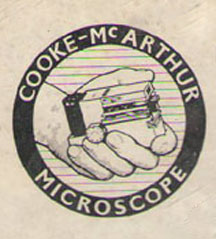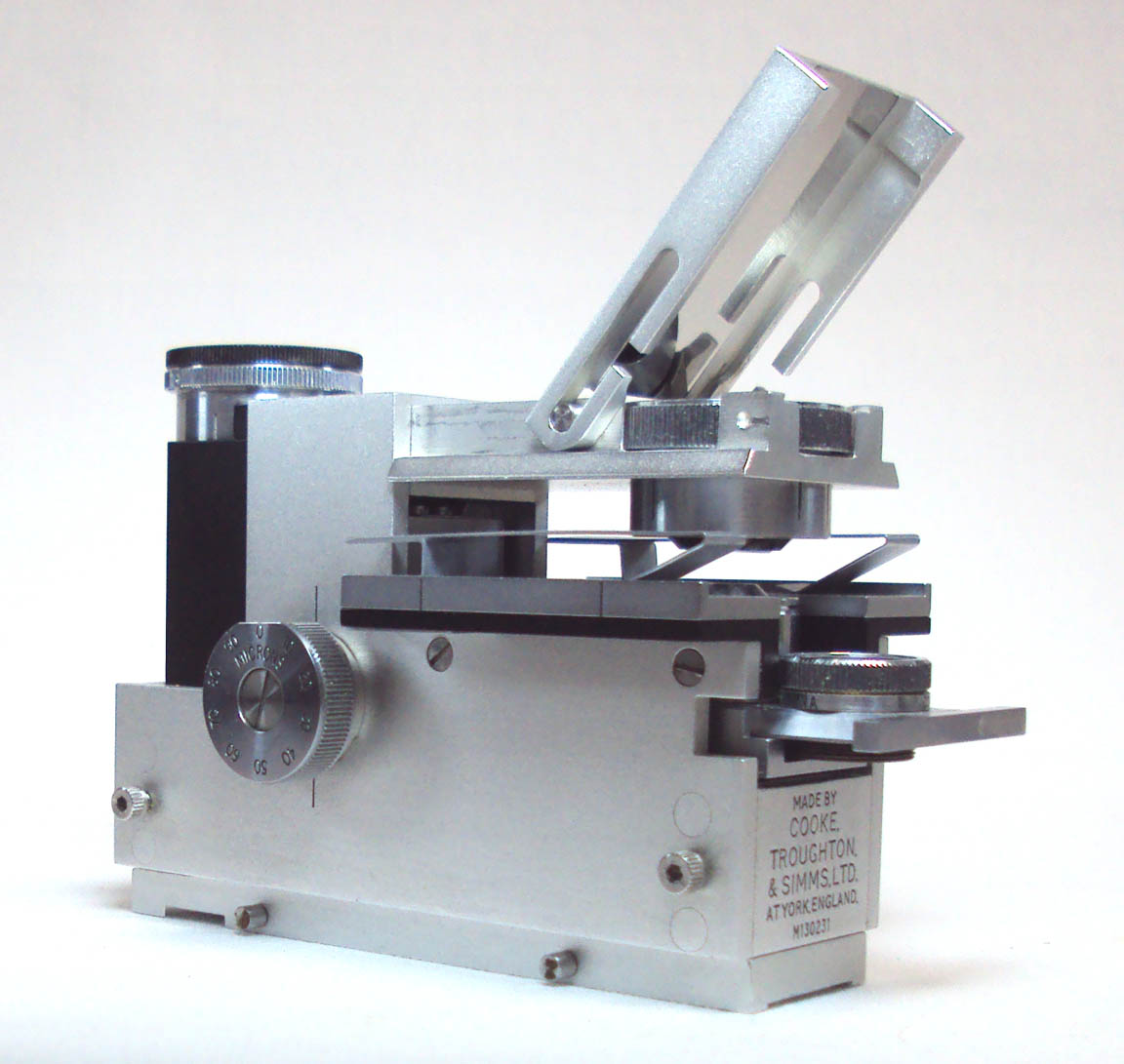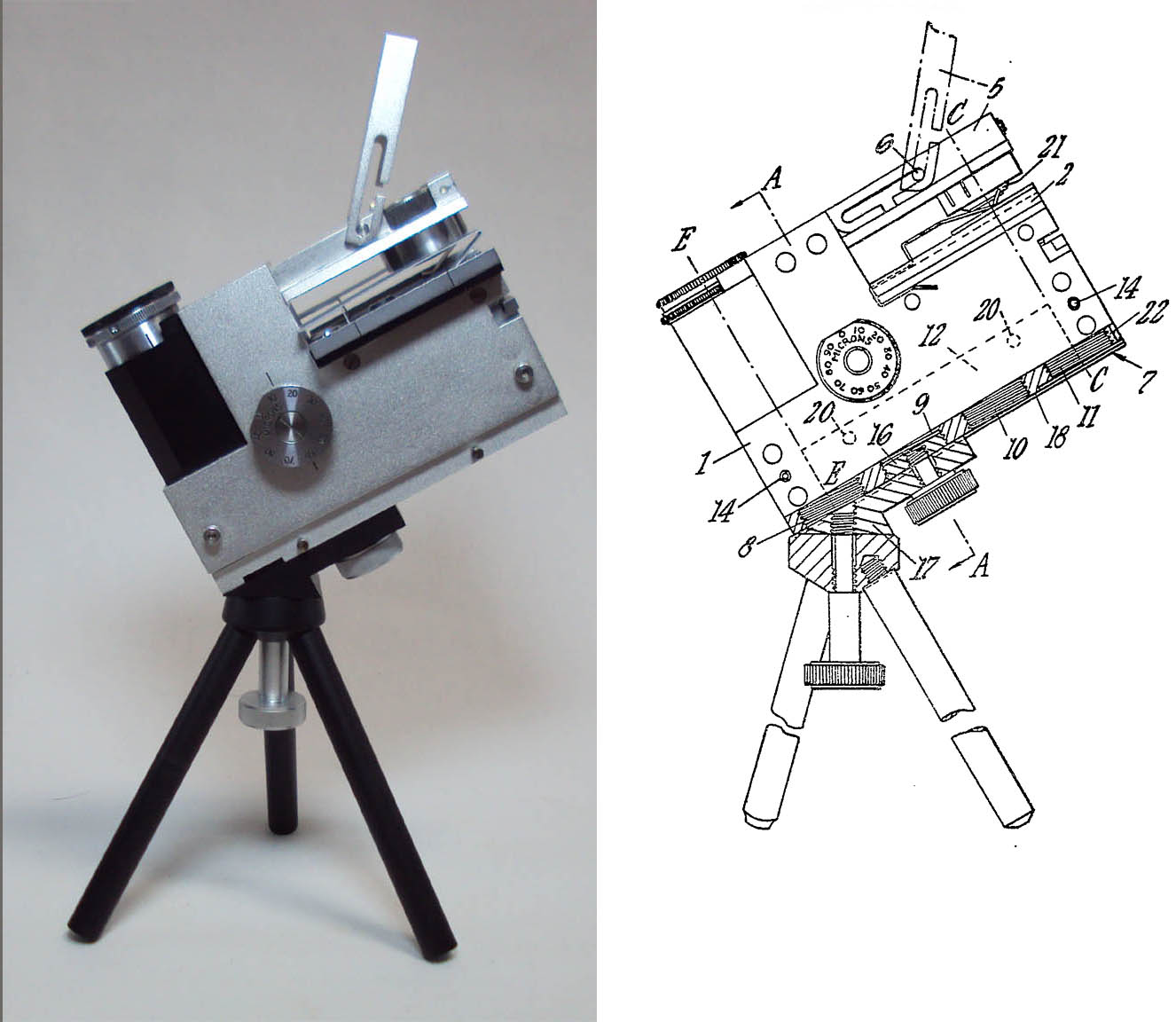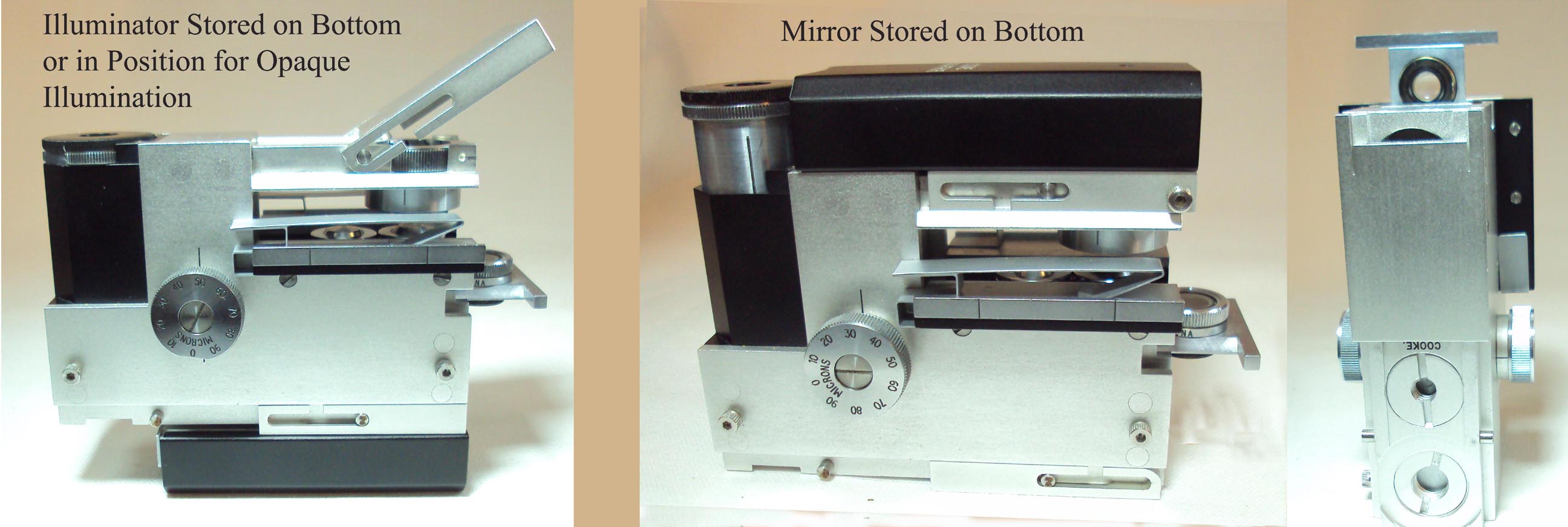MICROSCOPE-ANTIQUES.COM © 2013-15.
McARTHUR PORTABLE COMPOUND MICROSCOPE
c. 1960
SIGNED ON TOP: 'Cooke-McArthur'
SIGNED ON FRONT: 'Made by Cooke, Troughton & Simms Ltd at York, England M130231'
SIGNED ON BACK: 'PAT No 863102'
SERIAL NUMBER: none
MODEL: COOKE-MCARTHUR PORTABLE MICROSCOPE

DESCRIPTION:
 This instrument measures 4 x 3 1/4 x 2 inches
in widest dimensions. The main body is made of an aluminum alloy, so that, although solid and firm, it weighs about 16 ounces; compare
this to the weight of the original McArthur-Watson which weighed 3 pounds, 12 ounces.
This Cooke-McArthur came with the original McArthur patented bottom plate and tripod, as pictured to the left and in more
detail here.
This instrument measures 4 x 3 1/4 x 2 inches
in widest dimensions. The main body is made of an aluminum alloy, so that, although solid and firm, it weighs about 16 ounces; compare
this to the weight of the original McArthur-Watson which weighed 3 pounds, 12 ounces.
This Cooke-McArthur came with the original McArthur patented bottom plate and tripod, as pictured to the left and in more
detail here.
The British patent
was first filed in June of 1958, given a priority date of 1959, and published in 1961. This
patent mainly addresses two features: the bottom plate and the use of pins on the condenser arm to attach the mirror or, alternatively the electric illuminator.
This instrument came complete with many accessories including:
- Two stage clips
- An electric illuminator, called a 'Built In Electric Lamp Outfit.' powered by two AA batteries and actuated by turning a supplied control ring around the eyepiece, which is referred to as a 'rotating switch.' There was also a small screwdriver, 4 mercury batteries, and a diffusing screeen as well as a spare bulb listed on the the box label for this accessory. The original batteries and the diffusing screen are no longer present. The box also lists an 'external connector' also lacking.
- A standard mirror fitting with stainless steel mirror
- A (added later) lying drop slide signed Burwell Engineering
- A water-immersion dark ground condenser signed 'DG' which came in its black box with a list of contents which included the condenser, a Funnel stop for the oil immersion objective, and a box of 50 microscope slides ('0.8-1.0 mm thick') and a '1/4 oz box of cover glasses' The slides are by Arnold Horwell Ltd of London and are labelled as 'Made in Belgium.' Each slide is separated from the others with brown porous paper. The dark ground condenser was designed to work best with slides no thicker than 1mm, hence a box of the the appropriate slides was supplied with the condenser outfit.
- A phase contrast condenser signed 'PH'
- A bright field condenser with adjustable iris diaphragm
- An objective plate containing the three original objectives as listed on the original box, all signed 'Cooke,' (see below).
- Two spare electric bulbs
- A single Watson and Son 10X eyepiece
- A small bound instruction booklet with orange covers with a single illustration, and two additional loose pages unbound, describing the use of the dark ground condenser and electric illuminator.
- An integral draw tube about one inch long, but with no markings (the Kirk-McArthur model has a circumferential line about half way).
- A purpose-made 'Perspex' plastic case and its original cardboard box
- The 'Bench Tripod Outfit,' made of lightweight alloy, with original box,
complete with an angled attachment and six leg pieces, of which either three can be used or the other three can be added on to make the tripod higher. The angle piece may be used exactly as in the patent drawing shown above, or the microscope can just as easily be erected on the tripod in a horizontal
position for examining wet specimens. The patented foot plate, with inserts which can be moved to different positions on the plate,
is also included. The illuminator can be attached to this footplate allowing illumination of opaque objects with the special optical tube with a third opening.
- A Cooke-McArthur Accessory phototube
- An AC adapter for the Illuminator
- Four original black boxes with typewritten detailed labels and the Cooke McArthur Microscope Logo
Additional accessories were offered by CTS. These included three different types of inserts for the illuminator which took the place of the battery, and by wire, attached to external power sources. The types of inserts included a simple insert which simply hooked up to external power, an insert with fixed resistance, dropping 3 volts down to two, and a variable resistance insert with a small knurled knob at its rear to vary the voltage. The body of these needed to be nonconductive, so they were all made of Ebonite, except for the electrically conducting parts. All these were the size of the battery normally used (AA). Besides the standard achromatic objectives, flourite objectives and special purpose-made condensers for use with them were also offered. Three different carrying cases were available; these included the Perspex case seen with my microscope, and two different leather cases, the slightly larger one allowing the microscope with its illuminator to fit inside. A matching belt to carry the instrument on the waist was also available. The larger leather case can be seen with an example of Dr Goren's microscope here. As noted above, and shown in the image below, using the illuminator attached to the footplate, and changing the standard optical prism tube to a beam-splitting tube, incident illumination of opaque objects could be accomplished. There were at least three prismatic light tubes available, the standard, an erecting light tube allowing easier use for e.g. dissection, and a beam-splitting or photo optical tube allowing incident illumination and photography. The standard tube gives appropriate up and down views but right to left movement is seen reversed in the eyepiece.

The objective plate holds the three brightfield objectives, all signed 'Cooke. The low power has the additional engravings '87417 16 mm achro 0.2 NA.' The 40X has the serial number 91244 and also engraved '40X, 0.85'. The 100X has the serial number 91839 and is also engraved '100X, 1.3 OIL. Only the low power objective is knurled. These are the original objectives, and correspond exactly to the labelling on the original box. Although a phase contrast condenser is present, no phase contrast objectives are currently with this outfit. It should be noted that the objective plate supplied with the Kirk-McArthur does fit the dovetail in the Cooke-McArthur, but the fit is not as exact as the original Cooke objective plate, being slightly narrower.
I have recently been able to add lying drop slides
obtained in 2013 from Burwell engineering in Cambridge, UK.
I have discovered that the fittings on the end of the stage clips which make contact with the slide are tender and
break if bent; to increase the tension of the stage clips, the clips should be bent further in their middle rather than
the end if increased tension is required!
HISTORY: This is the Cooke, Troughton and Simms (CTS) version of the famous McArthur microscope, called the Cooke-McArthur model.
It incorportates almost all of the improvements made in the design. The quality and precision of the instrument
are really quite impressive. CTS was a subdivision of Vickers Ltd; after Vickers Ltd became Vickers Instruments (about 1962-3), the microscope label changed to 'Made by Vickers Instruments in England M130553.' To the best of my knowlege, there is no difference between the CTS model and the Vickers model, other than the signatures (see Dr Goren's Vickers Model here). The patent, filed in 1959, addresses the bottom plate and the use of pins to attach the mirror or the illuminator to the condenser arm.
For much more on the history of the McArthur microscope, please see my McArthur Main page.


 This instrument measures 4 x 3 1/4 x 2 inches
in widest dimensions. The main body is made of an aluminum alloy, so that, although solid and firm, it weighs about 16 ounces; compare
this to the weight of the original McArthur-Watson which weighed 3 pounds, 12 ounces.
This Cooke-McArthur came with the original McArthur patented bottom plate and tripod, as pictured to the left and in more
detail here.
This instrument measures 4 x 3 1/4 x 2 inches
in widest dimensions. The main body is made of an aluminum alloy, so that, although solid and firm, it weighs about 16 ounces; compare
this to the weight of the original McArthur-Watson which weighed 3 pounds, 12 ounces.
This Cooke-McArthur came with the original McArthur patented bottom plate and tripod, as pictured to the left and in more
detail here. 